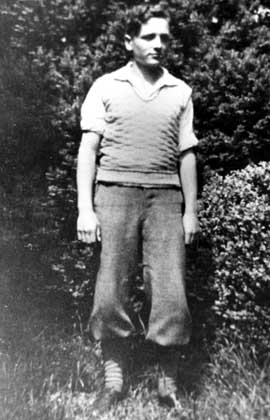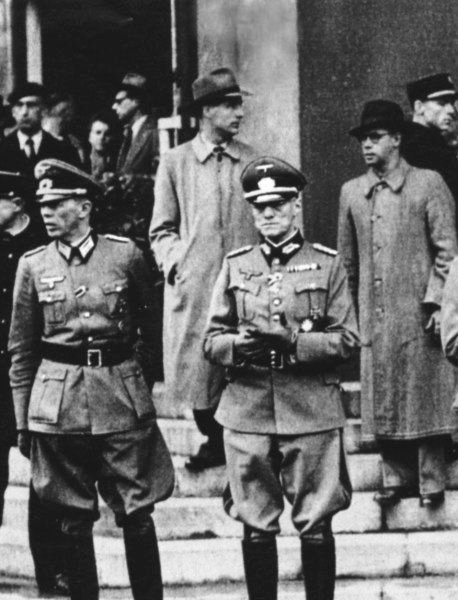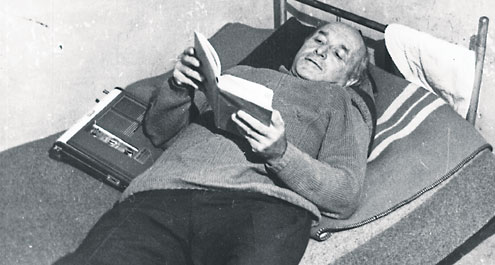Holocaust Education & Archive Research Team |
|
Occupation German Occupation of Europe Timeline
-
[The Occupied Nations]
Poland Austria Belgium Bulgaria Denmark France Germany Greece Hungary Italy Luxembourg The Netherlands Norway Romania Slovakia Soviet Union Sudetenland | ||||||
Klaus Barbie The Butcher of Lyon
Nikolaus Klaus Barbie was born on the 25 October 1913 in Bad Godesberg a small town next to the Rhine, south of Bonn Germany. His father also called Nikolaus who was an office worker then a primary school teacher at the Noder school, where the younger Barbie was also a pupil.
Barbie’s father fought in the First World War where he was wounded at Verdun, hit by a bullet in his neck, he returned home a bitter dejected man.
In 1923 Barbie was accepted into the Friedrich – Welhelm grammar school in Trier, he was joined by his family in Trier in 1925 when his father retired and he moved with his wife to where Barbie was studying.
In 1933 Barbie’s father and younger brother died and a year later he passed his graduation exams but with no money to continue his studies he became attracted to Nazism, and he volunteered for a six month stint in a Nazi Party voluntary work camp in Schleswig- Holstein.
On the 26 September 1935 Barbie joined the SS, membership number 272, 284 and eventually joined the SD (Sicherheitsdienst – Security Service) arm of the SS.
His first attachment was in Berlin, as an assistant in department IV –D of the SD main office and within weeks he was posted to police headquarters in the Alexanderplatz to start training as an investigator and interrogator, which he was to put into brutal effect during the Second World War.
After service in the Berlin vice squad he was transferred to Dusseldorf and in 1937 after joining the Nazi Party, and graduated from the SD school at Bernau and was sent to an exclusive leadership course in Berlin Charlottenburg. For three months from September 1938 he served with the 39th Infantry Regiment before returning to Charlottenburg for his final training and exams.
On 20 April 1940 he graduated and was promoted to SS –Untersturmfuhrer and five days later he married Regine Willms, a stocky twenty-three year old daughter of a postal worker from Osburg. Almost immediately after the wedding Barbie rejoined his SD detachment and was part of von Runstedt’s army invading the Low Countries and France.
Barbie was officially posted to Holland on the 29 May 1940, Barbie’s SD unit was under the direct command of Willy Lages, the SD commander in the Hague, and his unit was shortly afterwards transferred to the Zentralstelle in Amsterdam, the “Central Bureau for Jewish Emigration.” Barbie’s responsibilities included rounding up German émigrés, freemasons and Jews.
On the 12 February 1941, the German authorities used the death of a Dutch Nazi, Hendrik Koot killed in a fight with Dutch dockworkers, as a pretext to seal off the Jewish quarter of Amsterdam.
On 19 February 1941 an SD raid in Amsterdam entered a tavern called Koco, run by Jewish refugees from Germany, Cahn and Kohn. In the tavern, a protective device which Cahn had installed, an ammonia flash went off by accident, spaying the Germans with ammonia.
The SD raid was commanded by Klaus Barbie and after some violence everyone inside was arrested and three days later, as a reprisal for his act of “resistance” , the SS raided the Jewish quarter of Amsterdam, seized 425 Jews, most of them young men.
They were assembled on the Jonas Daniel –Meyer –plein subjected them to beatings and abuse and then on 27 February 1941 deported 389 of them to Buchenwald concentration camp and after two months 361 of them were deported to Mauthausen concentration camp and certain death.
The arrests were followed by a general strike, Barbie was ordered to execute Cahn and his associates, who had been condemned to death. Barbie was put in charge of the execution squad.
He recalled:
“One of the condemned asked to hear an American hit record and then we shot them.” On the 14 May 1941 a bomb was thrown into a Germans officers club in Amsterdam, and the German authorities decided the Jews should suffer as a reprisal.
Barbie went to the offices of the Jewish Council in Amsterdam met Abraham Asscher and David Cohen and Barbie tricked them into providing a list of 300 Jewish young men, on the basis they could return to the training camp and complete their apprenticeships. Asscher and Cohen were summonsed to see SD Commander Lages room and were told the boys had been arrested as a reprisal for the bomb attack.
Asscher and Cohen were taken out of the building past those Jewish boys who had been arrested. All the Jews were deported to Mauthausen concentration camp where they all died before the end of the year. Just days after this coup, Barbie’s daughter, Ute Regine, was born in Trier.
After a brief spell on the Eastern Front in the spring of 1942 he was recalled to Berlin to the French town of Gex, which is located on the border with Switzerland to carry out a kidnap attempt which never materialised. On the 11 November 1942 the German army crossed the demarcation line into the Vichy zone, and Barbie arrived in Lyons as head of the Gestapo.
The first SD commander for Lyons and the region was Rolf Muller, but he was transferred in early 1943 to Marseille. His position was filled temporarily by Fritz Hollert, who was replaced in the summer by Dr Werner Knab, a thirty-four year old lawyer born in Munich. Knab arrived directly from Kiev in Russia, where he had commanded the areas SS and SD forces.
During his time in Kiev he was responsible for the murders of countless Jews, and gypsies and communists, anyone the Nazis thought inferior, and he arrived in Lyons without any feelings for human life. He spoke both French and English and was completely dedicated to the course.
The Gestapo eventually selected the Hotel Terminus next to Perrache railway station until June 1943 when they moved into the vast Ecole de Sante Militaire on the Avenue Berholet.
Section IV, the Gestapo, was headed by Barbie, he divided his own department into six sub-sections specialising in:
Initially approximately twenty-five German officers worked directly under him. His leadership was efficient, dynamic and totally uncompromising.
On the 7 June 1943 Rene Hardy code-named “Didot,” head of the Resistance’s railway sabotage, boarded a train bound for Paris at the Perrache railway station in Lyons. His journey was cut short when he was arrested by the Gestapo eighty miles further on at Chalons –sur- Saone.
Two weeks after Hardy was arrested resistance leader Jean Moulin was captured at a resistance meeting in a doctor’s surgery in a big villa in Caluire, a suburb of Lyons and arrested by Barbie and died soon after that. The part played by Hardy in the betrayal and arrest of Jean Moulin, is still the matter of bitter dispute.
During the interrogations at the Ecole de Sante, someone revealed Moulin’s true identity, and he was brought from Montluc prison to the Gestapo headquarters for his first interrogation with Klaus Barbie.
Christian Pineau, the unofficial prison barber was ordered to shave Jean Moulin who was stretched out motionless on a bench:
“He had lost consciousness; his eyes were hollowed as if they were buried in his head. He had an ugly bluish wound on his temple. A low moan escaped from his swollen lips. There was no doubt that he had been tortured by the Gestapo. Seeing me hesitate, the officer said again, “Shave him!” I asked for some soap and water.
The officer brought some and then went away. Slowly I tried to shave him, trying not to touch the swollen parts of his face. I couldn’t understand why they wanted to put on this macabre performance for a dying man. When I’d finished I just sat next to him. Suddenly Moulin asked for some water.
I gave him a drink, then he spoke in a croaking voice a few words in English which I didn’t understand. Soon after he lost consciousness, I just sat with him, a sort of “death watch” until I was taken back to my cell.”
Gottlieb Fuchs the official interpreter of the Lyons Gestapo claimed that on the 25 June 1943 he witnessed Barbie drag a lifeless body down the steps to a basement in the Ecole de Sante. Fuchs later discovered that this victim was Moulin.
The Gestapo in the Avenue Foch in Paris ordered that all those arrested in Lyons should be brought to Paris for further investigations. Moulin was taken by Barbie at the end of June 1943. Moulin was taken to a large villa in Neuilly which had been requisitioned by General Bomelberg, the head of the Gestapo in France, and interrogated at the Avenue Foch.
On the 7 July an unconscious body on a stretcher was placed on a military train bound for Frankfurt-am –Main, Germany. Moulin was dead on arrival. Two days later the body was brought back to Paris and cremated at Pere Lachaise.
Barbie returned to Lyons and Raymond Aubrac one of those arrested in Caluire still remained in his care, and Barbie tortured him with unbridled ferocity. Aubrac recalled:
“Looking back, I sometimes even think that he wasn’t that interested in getting any information. Fundamentally he was a sadist who enjoyed causing pain and proving his power. He had an extraordinary fund of violence. Coshes, clubs and whips lay on his desk and he used them a lot.
Contrary to what some others say, he wasn’t even a good policeman, because he never got any information out of me. Not even my identity, or that I was Jewish.” Raymond Aubrac was rescued by members of the Resistance recruited by his courageous wife Lucie and they were both able to escape to England.
On the 30 March 1944 Lisa Lesevere was arrested carrying a letter addressed to man called “Didier” a low ranking resistance member responsible for dead letterboxes.
Brought before Barbie, the brutal Gestapo chief asked her to give him the real name of “Didier.” Lesevere pretended not to understand, thus Barbie began hitting the young woman and then summoned four assistants, including the infamous “Gueule Tordue”. This was Francois Andre an ex-communist, whose face had been deformed in a road accident, his mouth was twisted into the shape of a gaping wound.
Lesevere was hung from the ceiling by her wrists and beaten. The following day she was undressed, beaten and pushed into a bath. She fainted was revived by a doctor, to find Barbie and his agents laughing and offering a drink as if nothing had happened.
For nineteen days, the torture sessions continued. When her tortures temporarily ceased, she was forced to watch others suffer, including her own fifteen-year old son, whom Barbie had discovered. His parting words to his mother were, “Don’t forget that I am very soft.”
As the brutalities intensified, so did her resolve against divulging anything. But then after a mock execution, Barbie revealed that another girl from her own network had betrayed her.
Lesevere was tied, stomach- down onto an upturned chair, and “Gueule Tordue” began hitting her with a spiked ball hung from a cosh. Her vertebral column was broken and she fainted. Her first image, when she awoke, lying on the floor, were the legs of a young girl and the sound of her playing Chopin’s “L’Heroique” on the piano. Barbie leaned over her, stroking her hands.
“What you have done is magnificent, my dear. Nobody has held out as long as you. It’s nearly over now. I’m very upset. But let’s finish. Go on, a little effort. Who is “Didier?”
Lesevere said nothing. Hitting her on the face, Barbie shouted, “I don’t want to see this stupid young woman anymore. Get rid of her!” On the 6 April 1944 a squad of a dozen German soldiers led by Gestapo officers and milice drove from Lyons to the tiny and isolated village of Izieu.
Local milice had allegedly heard from Henri Bourdon, a local farmer, that for the past year the village’s largest house had been used as a school and refuge for Jewish children, aged from three to fourteen.
The school’s director Miron Zlatin was told by the Germans that the children were to be evacuated for their own safety. Fearing the worst he tried to dissuade the Gestapo officers from taking the children, having failed he told the children to pack their belongings and climb into the waiting lorries.
There is no reliable confirmation that Barbie was present when the home at Izieu, but his involvement in the subsequent deportation is beyond doubt:
At 8.10 that evening, a telex signed personally by Barbie was sent to Gestapo headquarters in Paris:
After leaving France Barbie returned to Germany and was posted to Halle, for front-line service. He fled the fighting and went to Berlin and then onto Dusseldorf.
Barbie himself recalled how the war ended for him:
“My war ended in Wuppertal. We turned a garage into a stronghold. Nearby were two trucks loaded with civilian clothes for the Werewolf’s (the abortive German resistance movement). But no one had made any plans to continue the fight underground, probably because no one thought that we would lose the war. So I buried my gun.
The four youngsters I was with and myself changed our clothes, got some false papers from the police headquarters and headed off through the forests and pastures towards the Sauerland. It was very hard. From one day to the next, I’d become a beggar.”
His luck ran out and he was arrested at an American roadblock near Hohenlimburg, where he was locked up in a school, but was soon released.
Barbie began working for the CIC in spring 1947, he was protected by American intelligence agents because of his “police skills” and anti-communist zeal – he was successful in penetrating communist cells in post-war Germany.
With the aid of the Americans he fled in 1950 to escape prosecution in France and relocated to Bolivia, South America together with his wife and children.
He lived in Bolivia as a businessman under the name of Klaus Altmann, though he was identified in Bolivia in the early 1970’s by the Nazi hunters Beate and Serge Klarsfeld, it was only in February 1983 that the Bolivian government, after long negotiations, extradited Barbie to France to stand trial for war crimes.
On the 3 July 1987 Klaus Barbie was sentenced to life imprisonment for crimes against humanity. Nine jurors and three judges found Barbie – known as the “Butcher of Lyons” – guilty of the 341 separate charges that were brought against him at the court in Lyon.
The 73-year old former Gestapo chief was accused of deporting 842 people – mainly Jews – to concentration camps during the Second World War.
Klaus Barbie died of cancer in prison on the 25 September 1991.
Sources:
Klaus Barbie by Tom Bower, published by Corgi Books 1984. The Final Solution by G. Reitlinger, published by Sphere Books Ltd 1971. The Yellow Star by Gerhard Schoenberner, published by Corgi Books 1978. Holocaust Historical Society National Archives – Kew Bundesarchive Koblenz
Copyright Chris Webb & Carmelo Lisciotto H.E.A.R.T 2009 | ||||||




%20regarding%20the%20deportation%20of%20a%20Jewish%20home%20for%20children%20in%20Lyon%20to%20the%20Drancy%20camp%20in%20Paris..jpg)


